RENAULT ALASKAN 2017 Owner's Guide
Manufacturer: RENAULT, Model Year: 2017, Model line: ALASKAN, Model: RENAULT ALASKAN 2017Pages: 340, PDF Size: 6.93 MB
Page 31 of 340
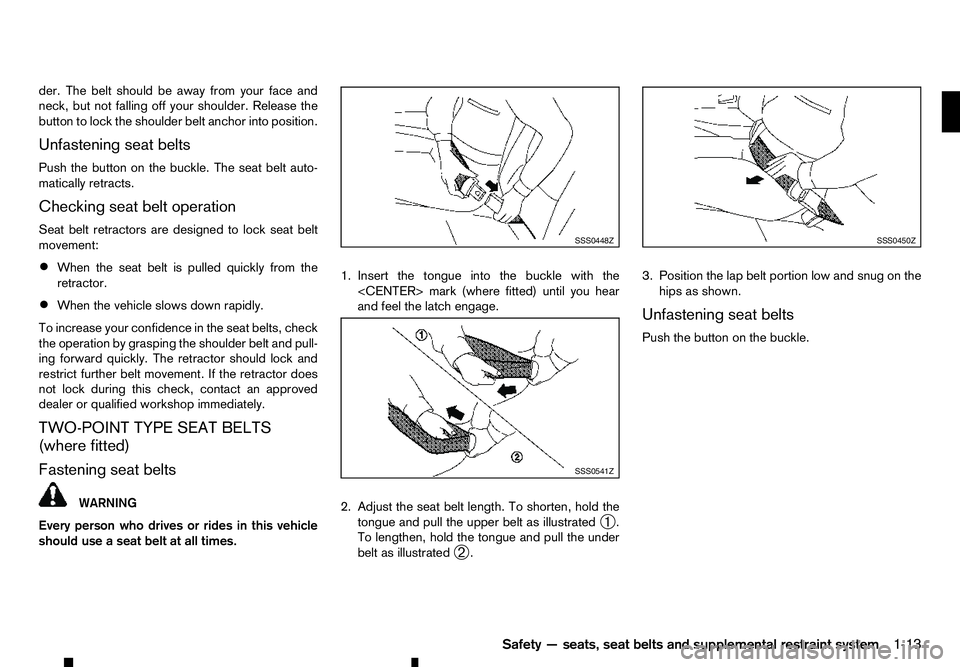
der. The belt should be away from your face and
neck, but not falling off your shoulder. Release the
button to lock the shoulder belt anchor into position.
Unfastening seat belts
Push the button on the buckle. The seat belt auto-
matically retracts.
Checking seat belt operation
Seat belt retractors are designed to lock seat belt
movement:
• When the seat belt is pulled quickly from the
retractor.
• When the vehicle slows down rapidly.
To increase your confidence in the seat belts, check
the operation by grasping the shoulder belt and pull-
ing forward quickly. The retractor should lock and
restrict further belt movement. If the retractor does
not lock during this check, contact an approved
dealer or qualified workshop immediately.
TWO-POINT TYPE SEAT BELTS (where fitted)
Fastening seat belts WARNING
Every person who drives or rides in this vehicle
should use aseat belt at all times. 1. Insert the tongue into the buckle with the
and feel the latch engage.
2. Adjust the seat belt length. To shorten, hold the tongue and pull the upper belt as illustrated ➀.
To lengthen, hold the tongue and pull the under
belt as illustrated ➁. 3. Position the lap belt portion low and snug on the
hips as shown.
Unfastening seat belts
Push the button on the buckle. SSS0448Z
SSS0541Z SSS0450Z
Safety —seats, seat belts and supplemental restraint system
1-13
Page 32 of 340
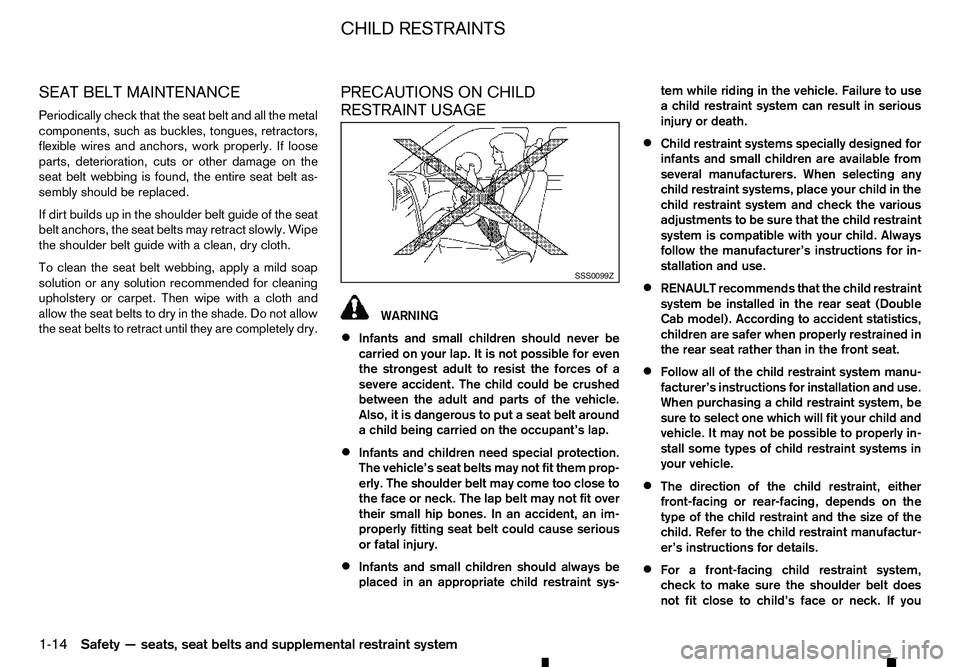
SEAT BELT MAINTENANCE
Periodically check that the seat belt and all the metal
components, such as buckles, tongues, retractors,
flexible wires and anchors, work properly. If loose
parts, deterioration, cuts or other damage on the
seat belt webbing is found, the entire seat belt as-
sembly should be replaced.
If dirt builds up in the shoulder belt guide of the seat
belt anchors, the seat belts may retract slowly. Wipe
the shoulder belt guide with aclean, dry cloth.
To clean the seat belt webbing, apply amild soap
solution or any solution recommended for cleaning
upholstery or carpet. Then wipe with acloth and
allow the seat belts to dry in the shade. Do not allow
the seat belts to retract until they are completely dry. PRECAUTIONS ON CHILD
RESTRAINT USAGE WARNING
• Infants and small children should never be
carried on your lap. It is not possible for even
the strongest adult to resist the forces of a
severe accident. The child could be crushed
between the adult and parts of the vehicle.
Also, it is dangerous to put aseat belt around
ac hild being carried on the occupant’s lap.
• Infants and children need special protection.
The vehicle’s seat belts may not fit them prop-
erly. The shoulder belt may come too close to
the face or neck. The lap belt may not fit over
their small hip bones. In an accident, an im-
properly fitting seat belt could cause serious
or fatal injury.
• Infants and small children should always be
placed in an appropriate child restraint sys- tem while riding in the vehicle. Failure to use
ac
hild restraint system can result in serious
injury or death.
• Child restraint systems specially designed for
infants and small children are available from
several manufacturers. When selecting any
child restraint systems, place your child in the
child restraint system and check the various
adjustments to be sure that the child restraint
system is compatible with your child. Always
follow the manufacturer’s instructions for in-
stallation and use.
• RENAULT recommends that the child restraint
system be installed in the rear seat (Double
Cab model). According to accident statistics,
children are safer when properly restrained in
the rear seat rather than in the front seat.
• Follow all of the child restraint system manu-
facturer’s instructions for installation and use.
When purchasing
achild restraint system, be
sure to select one which will fit your child and
vehicle. It may not be possible to properly in- stall some types of child restraint systems in
your vehicle.
• The direction of the child restraint, either
front-facing or rear-facing, depends on the
type of the child restraint and the size of the child. Refer to the child restraint manufactur-
er’s instructions for details.
• For
afront-facing child restraint system,
check to make sure the shoulder belt does
not fit close to child’s face or neck. If you SSS0099Z
CHILD RESTRAINTS
1-14 Safety —seats, seat belts and supplemental restraint system
Page 33 of 340

must install
afront-facing child restraint sys-
tem in the front seat, see “Installation on front
passenger’s seat” later in this section.
• Never install
arear-facing child restraint sys-
tem on the front passenger’s seat when the
front passenger’s air bag is active. Supple- mental front-impact air bags inflate with great
force. Arear-facing child restraint system
could be struck by the supplemental front-im-
pact air bags in an accident and could seri-
ously injure or kill your child.
• Do not install
achild restraint in the jump seats
(where fitted for King Cab model). These
seats are not suitable for child restraint instal-
lation.
• Adjustable seatbacks should be positioned to
fit
ac hild restraint system, but as upright as
possible. see “Installation on rear outboard
seats” later in this section and “Child restraint
installation using three-point type seat belt”
later in this section.
• If the seat belt in the position where
achild
restraint system is installed requires alocking
clip and if it is not used, injuries could result
from achild restraint system tipping over dur-
ing normal vehicle braking or cornering.
• After attaching
achild restraint system, test it
before you place the child in it. Tilt it from side
to side. Try to tug it forward and check if it is
held securely in place. The child restraint sys-
tem should not move more than 25 mm (1 in). If the restraint is not secure, tighten the belt
as necessary, or install the restraint in another
seat and test it again.
• Check the child restraint system in your ve-
hicle to be sure that it is compatible with the
vehicle’s seat belt system.
• If
ac hild restraint system is not anchored
properly, the risk of achild being injured in a
collision or asudden stop greatly increases.
• Improper use of
achild restraint system can
increase the risk or severity of injury for both
the child and other occupants in the vehicle.
• Always use an appropriate child restraint sys-
tem. An improperly installed child restraint
system could lead to serious injury or death in
an accident.
• When the child restraint system is not in use,
keep it secured with the ISOFIX and i-Size
child restraint system or
aseat belt to prevent
it from being thrown around in case of asud-
den stop or accident.
RENAULT recommends that infants and small chil-
dren be seated in achild restraint system. You
should choose achild restraint system that fits your
vehicle and always follow the manufacturer’s in-
structions for installation and use. In addition, there
are many types of child restraint systems available
for larger children that should be used for maximum
protection. CAUTION
Remember that
achild restraint system left in a
closed vehicle can become very hot. Check the
seating surface and buckles before placing your
child in achild restraint system.
UNIVERSAL CHILD RESTRAINTS FOR
FRONT SEAT AND REAR SEATS (for
Europe)
NOTE
Child restraints approved to UN Regulation No.
44 or No. 129 are clearly marked with the catego-
ries such as Universal, Semi-universal or ISOFIX.
When selecting any child restraint, keep the follow-
ing points in mind:
• Choose
achild restraint that complies with the
latest European safety standard, UN Regulation
No. 44 or No. 129.
• Place your child in the child restraint and check
the various adjustments to be sure the child re-
straint is compatible with your child. Always fol-
low all of the recommended procedures.
• Check the child restraint in your vehicle to be
sure it is compatible with vehicle’s retention sys-
tem.
• Refer to the tables later in this section for
alist of
the recommended fitment positions and the ap-
proved child restraints for your vehicle.
Safety —seats, seat belts and supplemental restraint system 1-15
Page 34 of 340
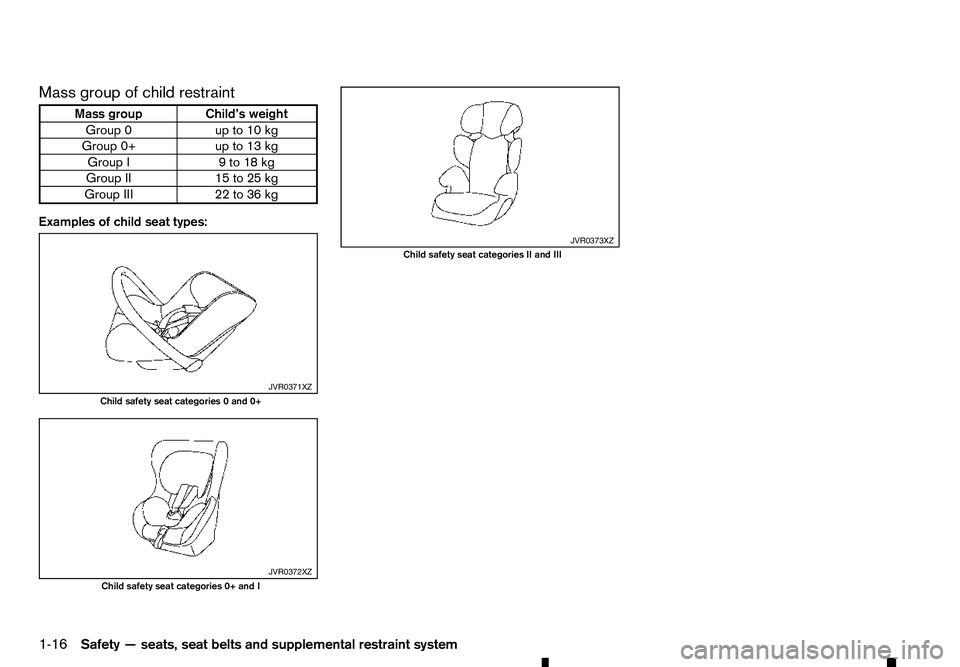
Mass group of child restraint
Mass group Child’s weight
Group 0u pto10kg
Group 0+ up to 13 kg
Group I9 to 18 kg
Group II 15 to 25 kg
Group III 22 to 36 kg
Examples of child seat types: JVR0371XZ
Child safety seat categories
0and 0+ JVR0372XZ
Child safety seat categories 0+ and I JVR0373XZ
Child safety seat categories II and III
1-16 Safety —seats, seat belts and supplemental restraint system
Page 35 of 340
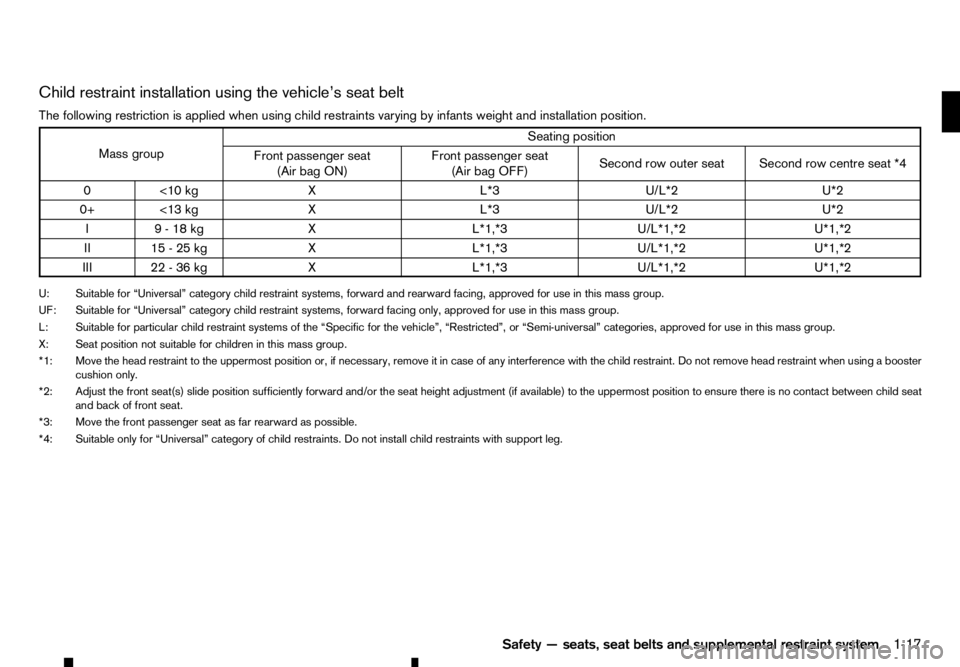
Child restraint installation using the vehicle’s seat belt
The following restriction is applied when using child restraints varying by infants weight and installation position. Mass group
Seating position
Front passenger seat (Air bag ON) Front passenger seat
(Air bag OFF) Second row outer seat Second row centre seat *4
0< 10 kg XL *3U/L*2 U*2
0+ <13 kg XL *3U/L*2 U*2
I9 -18kgX L*1,*3U/L*1,*2 U*1,*2
II 15 -25kgX L*1,*3U/L*1,*2 U*1,*2
III 22 -36kgX L*1,*3U/L*1,*2 U*1,*2
U: Suitable for “Universal” category child restraint systems, forward and rearward facing, approved for use in this mass group.
UF: Suitable for “Universal” category child restraint systems, forward facing only, approved for use in this mass group.
L: Suitable for particular child restraint systems of the “Specific for the vehicle”, “Restricted”, or “Semi-universal” categories, approved for use in this mass group. X: Seat position not suitable for children in this mass group.
*1: Move the head restraint to the uppermost position or, if necessary, remove it in case of any interference with the child restraint. Do not remove head restraint when using abooster
cushion only.
*2: Adjust the front seat(s) slide position sufficiently forward and/or the seat height adjustment (if available) to the uppermost position to ensure there is no contact between child seat and back of front seat.
*3: Move the front passenger seat as far rearward as possible.
*4: Suitable only for “Universal” category of child restraints. Do not install child restraints with support leg.
Safety—seats, seat belts and supplemental restraint system 1-17
Page 36 of 340
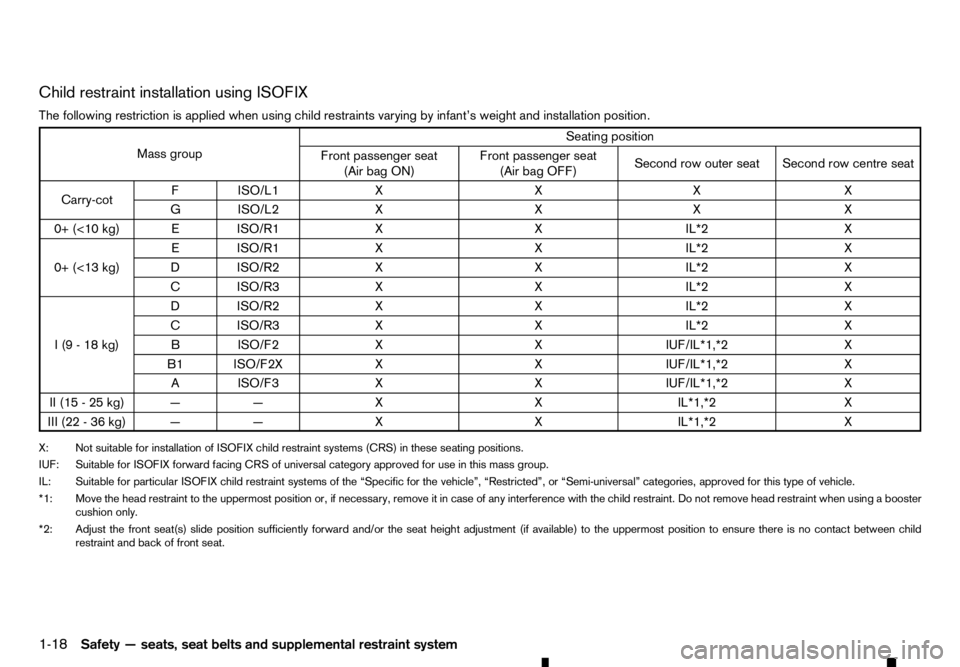
Child restraint installation using ISOFIX
The following restriction is applied when using child restraints varying by infant’s weight and installation position. Mass group
Seating position
Front passenger seat (Air bag ON) Front passenger seat
(Air bag OFF) Second row outer seat Second row centre seat
Carry-cot FI
SO/L1 XX XX
GI SO/L2 XX XX
0+ (<10 kg) EISO/R1 XX IL*2X
0+ (<13 kg) EI
SO/R1 XX IL*2X
DI SO/R2 XX IL*2X
CI SO/R3 XX IL*2X
I(9-18k g) DI
SO/R2 XX IL*2X
CI SO/R3 XX IL*2X
BI SO/F2 XX IUF/IL*1,*2X
B1 ISO/F2X XX IUF/IL*1,*2X
AI SO/F3 XX IUF/IL*1,*2X
II (15 -25kg) —— XX IL*1,*2X
III (22 -36kg) —— XX IL*1,*2X
X: Not suitable for installation of ISOFIX child restraint systems (CRS) in these seating positions.
IUF: Suitable for ISOFIX forward facing CRS of universal category approved for use in this mass group.
IL: Suitable for particular ISOFIX child restraint systems of the “Specific for the vehicle”, “Restricted”, or “Semi-universal” categories, approved for this type of vehicle.
*1: Move the head restraint to the uppermost position or, if necessary, remove it in case of any interference with the child restraint. Do not remove head restraint when using abooster
cushion only.
*2: Adjust the front seat(s) slide position sufficiently forward and/or the seat height adjustment (if available) to the uppermost position to ensure there is no contact between child restraint and back of front seat.
1-18 Safety —seats, seat belts and supplemental restraint system
Page 37 of 340
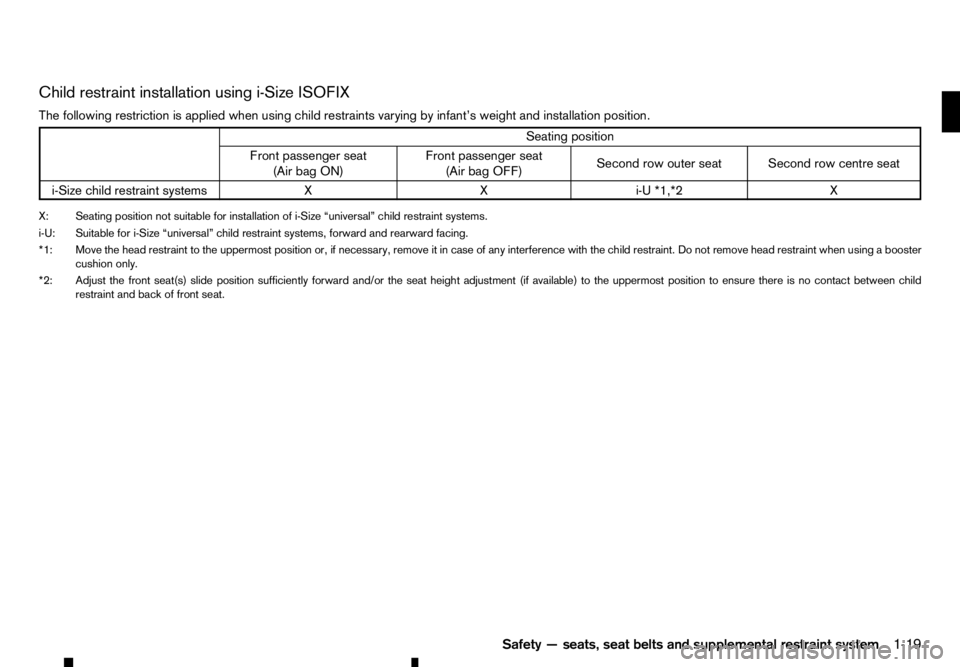
Child restraint installation using i-Size ISOFIX
The following restriction is applied when using child restraints varying by infant’s weight and installation position. Seating position
Front passenger seat (Air bag ON) Front passenger seat
(Air bag OFF) Second row outer seat Second row centre seat
i-Size child restraint systems XX i-U *1,*2X
X: Seating position not suitable for installation of i-Size “universal” child restraint systems.
i-U: Suitable for i-Size “universal” child restraint systems, forward and rearward facing.
*1: Move the head restraint to the uppermost position or, if necessary, remove it in case of any interference with the child restraint. Do not remove head restraint when using abooster
cushion only.
*2: Adjust the front seat(s) slide position sufficiently forward and/or the seat height adjustment (if available) to the uppermost position to ensure there is no contact between child restraint and back of front seat.
Safety—seats, seat belts and supplemental restraint system 1-19
Page 38 of 340
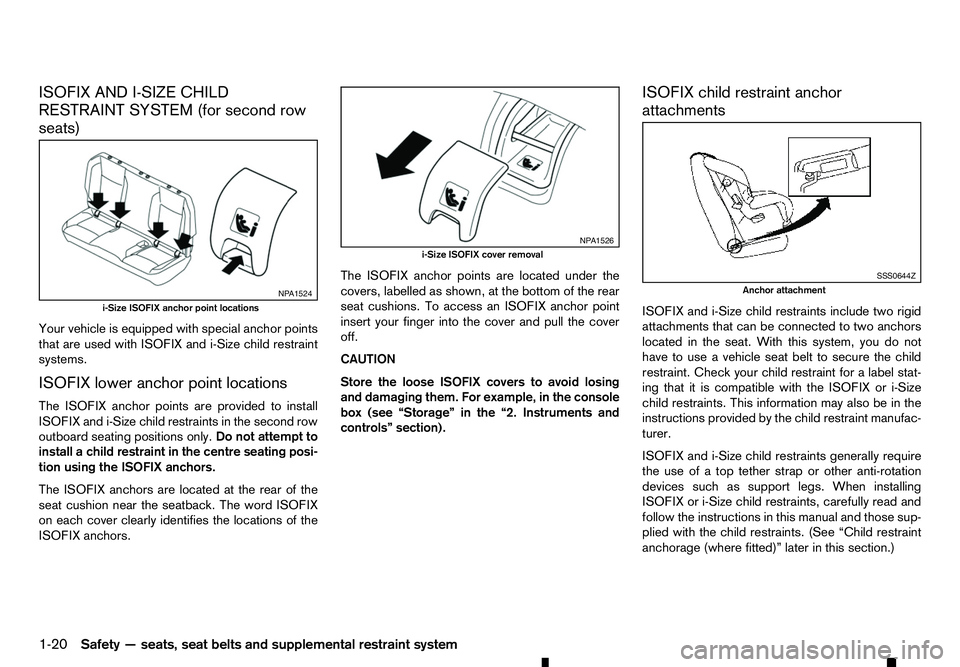
ISOFIX AND I-SIZE CHILD
RESTRAINT SYSTEM (for second row
seats)
Your vehicle is equipped with special anchor points
that are used with ISOFIX and i-Size child restraint
systems.
ISOFIX lower anchor point locations
The ISOFIX anchor points are provided to install
ISOFIX and i-Size child restraints in the second row
outboard seating positions only. Do not attempt to
install achild restraint in the centre seating posi-
tion using the ISOFIX anchors.
The ISOFIX anchors are located at the rear of the
seat cushion near the seatback. The word ISOFIX
on each cover clearly identifies the locations of the
ISOFIX anchors. The ISOFIX anchor points are located under the
covers, labelled as shown, at the bottom of the rear
seat cushions. To access an ISOFIX anchor point
insert your finger into the cover and pull the cover
off.
CAUTION
Store the loose ISOFIX covers to avoid losing
and damaging them. For example, in the console
box (see “Storage” in the “2. Instruments and
controls” section).ISOFIX child restraint anchor
attachments
ISOFIX and i-Size child restraints include two rigid
attachments that can be connected to two anchors
located in the seat. With this system, you do not
have to use
avehicle seat belt to secure the child
restraint. Check your child restraint for alabel stat-
ing that it is compatible with the ISOFIX or i-Size
child restraints. This information may also be in the
instructions provided by the child restraint manufac-
turer.
ISOFIX and i-Size child restraints generally require the use of atop tether strap or other anti-rotation
devices such as support legs. When installing
ISOFIX or i-Size child restraints, carefully read and
follow the instructions in this manual and those sup-
plied with the child restraints. (See “Child restraint
anchorage (where fitted)” later in this section.) NP A1524
i-Size ISOFIX anchor point locations NP A1526
i-Size ISOFIX cover removal SSS0644Z
Anchor attachment
1-20 Safety —seats, seat belts and supplemental restraint system
Page 39 of 340
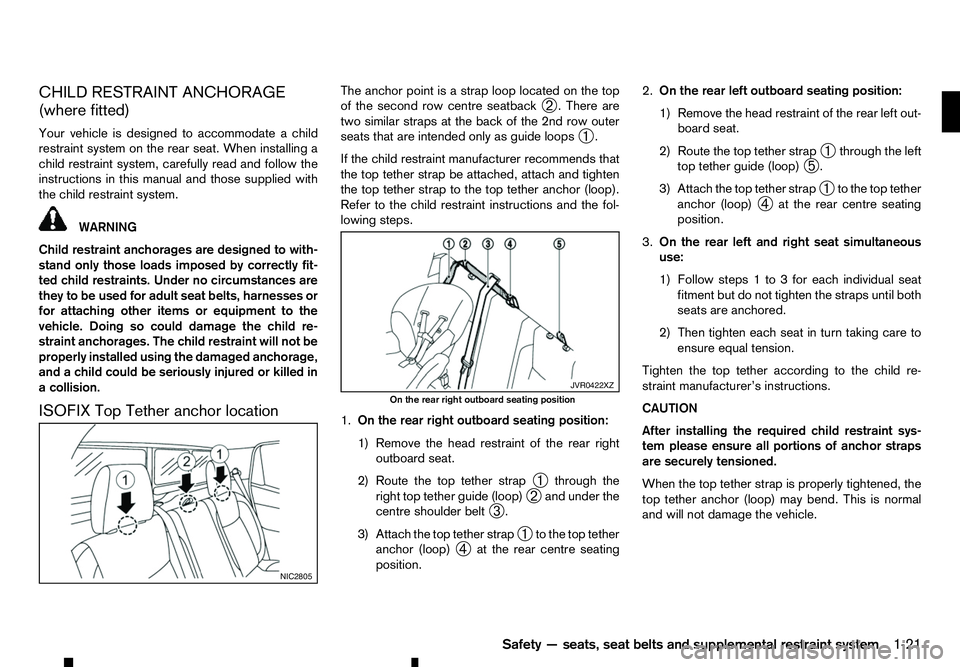
CHILD RESTRAINT ANCHORAGE
(where fitted)
Your vehicle is designed to accommodate achild
restraint system on the rear seat. When installing a
child restraint system, carefully read and follow the instructions in this manual and those supplied with
the child restraint system. WARNING
Child restraint anchorages are designed to with-
stand only those loads imposed by correctly fit-
ted child restraints. Under no circumstances are
they to be used for adult seat belts, harnesses or
for attaching other items or equipment to the
vehicle. Doing so could damage the child re-
straint anchorages. The child restraint will not be
properly installed using the damaged anchorage,
and achild could be seriously injured or killed in
ac ollision.
ISOFIX Top Tether anchor location The anchor point is
astrap loop located on the top
of the second row centre seatback ➁.T
here are
two similar straps at the back of the 2nd row outer
seats that are intended only as guide loops ➀.
If the child restraint manufacturer recommends that
the top tether strap be attached, attach and tighten
the top tether strap to the top tether anchor (loop).
Refer to the child restraint instructions and the fol-
lowing steps.
1. On the rear right outboard seating position:
1) Remove the head restraint of the rear right
outboard seat.
2) Route the top tether strap ➀through the
right top tether guide (loop) ➁and under the
centre shoulder belt ➂.
3) Attach the top tether strap ➀to the top tether
anchor (loop) ➃at the rear centre seating
position. 2.
On the rear left outboard seating position:
1) Remove the head restraint of the rear left out-
board seat.
2) Route the top tether strap ➀through the left
top tether guide (loop) ➄.
3) Attach the top tether strap ➀to the top tether
anchor (loop) ➃at the rear centre seating
position.
3. On the rear left and right seat simultaneous
use:
1) Follow steps 1to3for each individual seat
fitment but do not tighten the straps until both
seats are anchored.
2) Then tighten each seat in turn taking care to ensure equal tension.
Tighten the top tether according to the child re-
straint manufacturer’s instructions.
CAUTION
After installing the required child restraint sys-
tem please ensure all portions of anchor straps
are securely tensioned.
When the top tether strap is properly tightened, the
top tether anchor (loop) may bend. This is normal
and will not damage the vehicle. NIC2805 JVR0422XZ
On the rear right outboard seating position
Safety—seats, seat belts and supplemental restraint system 1-21
Page 40 of 340
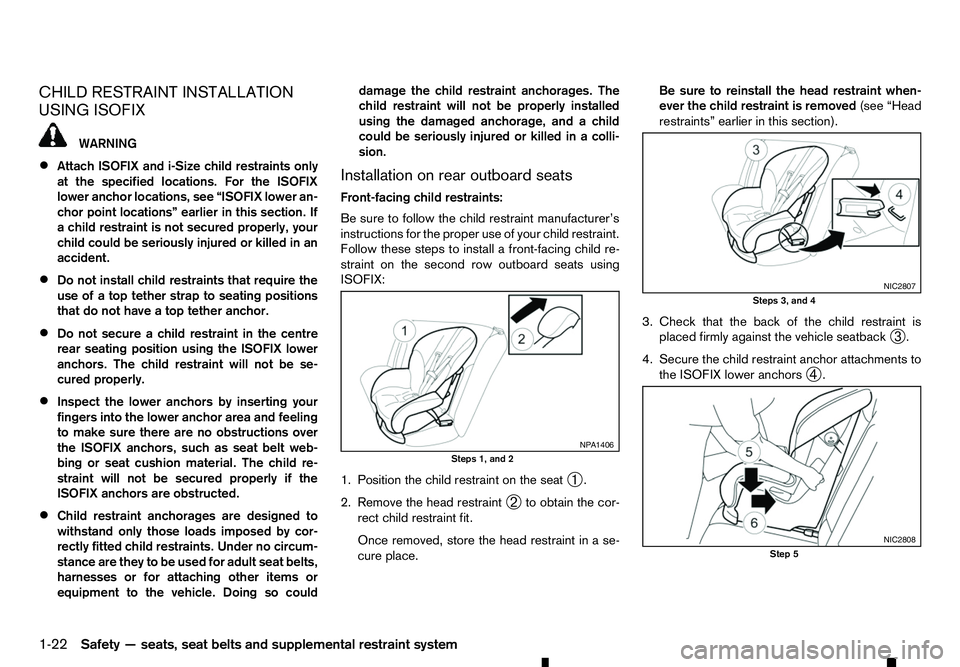
CHILD RESTRAINT INSTALLATION
USING ISOFIX WARNING
• Attach ISOFIX and i-Size child restraints only
at the specified locations. For the ISOFIX
lower anchor locations, see “ISOFIX lower an-
chor point locations” earlier in this section. If
ac hild restraint is not secured properly, your
child could be seriously injured or killed in an
accident.
• Do not install child restraints that require the
use of
atop tether strap to seating positions
that do not have atop tether anchor.
• Do not secure
achild restraint in the centre
rear seating position using the ISOFIX lower
anchors. The child restraint will not be se-
cured properly.
• Inspect the lower anchors by inserting your
fingers into the lower anchor area and feeling
to make sure there are no obstructions over the ISOFIX anchors, such as seat belt web-
bing or seat cushion material. The child re-
straint will not be secured properly if the
ISOFIX anchors are obstructed.
• Child restraint anchorages are designed to
withstand only those loads imposed by cor-
rectly fitted child restraints. Under no circum-
stance are they to be used for adult seat belts,
harnesses or for attaching other items or
equipment to the vehicle. Doing so could damage the child restraint anchorages. The
child restraint will not be properly installed
using the damaged anchorage, and
achild
could be seriously injured or killed in acolli-
sion.
Installation on rear outboard seats
Front-facing child restraints:
Be sure to follow the child restraint manufacturer’s
instructions for the proper use of your child restraint.
Follow these steps to install afront-facing child re-
straint on the second row outboard seats using
ISOFIX:
1. Position the child restraint on the seat ➀.
2. Remove the head restraint ➁to obtain the cor-
rect child restraint fit.
Once removed, store the head restraint in ase-
cure place. Be sure to reinstall the head restraint when-
ever the child restraint is removed
(see “Head
restraints” earlier in this section).
3. Check that the back of the child restraint is placed firmly against the vehicle seatback ➂.
4. Secure the child restraint anchor attachments to the ISOFIX lower anchors ➃. NP A1406
Steps 1, and 2 NIC2807
Steps 3, and 4
NIC2808
Step 5
1-22 Safety —seats, seat belts and supplemental restraint system